Facile Histamine Detection by Surface-Enhanced Raman Scattering Using SiO2@Au@Ag Alloy Nanoparticles
Abstract
1. Introduction
2. Results and Discussion
2.1. Characterization of the SiO2@Au@Ag NPs
2.2. Optimization of Histamine Detection
2.2.1. Effect of Target Volume on Histamine Detection
2.2.2. Effect of Incubation Time on Histamine Detection
2.2.3. Effect of Solvent pH on Histamine Detection
2.2.4. Effect of the Material Concentration on the SERS Signal of Histamine
2.3. The Limit of Detection (LOD) of Histamine
3. Materials and Methods
3.1. Chemicals and Materials
3.2. Preparation of SiO2@Au@Ag NPs
3.3. Histamine Detection
3.4. SERS Measurement of SiO2@Au@Ag@Histamine
4. Conclusions
Supplementary Materials
Author Contributions
Funding
Acknowledgments
Conflicts of Interest
Abbreviations
| AgNO3 | Silver nitrate |
| APTS | 3-Aminopropyltriethoxysilane |
| CE | Capillary electrophoresis |
| ELISA | Enzyme linked immunosorbent assay |
| EtOH | Ethyl alcohol |
| EU | European Union |
| FDA | U.S. Food and Drug Administration |
| HAuCl4 | Gold (III) chloride trihydrate |
| HCl | Hydrochloric acid |
| HPLC | High-performance liquid chromatography |
| LOD | Limit of detection |
| NaOH | Sodium hydroxide |
| NH4OH | Ammonium hydroxide |
| NPs | Nanoparticles |
| PBS-T | Phosphate-buffered saline-Tween 20 |
| PVP | Polyvinylpyrrolidone |
| S/N | Signal to noise ratio |
| SERS | Surface-enhanced Raman scattering |
| SiO2@Au@Ag | Gold–silver alloy-embedded silica |
| TEM | Transmission electron microscopy |
| TEOS | Tetraethylorthosilicate |
| THPC | Tetrakis(hydroxymethyl)phosphonium chloride |
References
- Janči, T.; Valinger, D.; Kljusurić, J.G.; Mikac, L.; Filipec, S.V.; Ivanda, M. Determination of histamine in fish by Surface Enhanced Raman Spectroscopy using silver colloid SERS substrates. Food Chem. 2017, 224, 48–54. [Google Scholar] [CrossRef] [PubMed]
- Chu, B.Q.; Lin, L.; He, Y. Rapid determination of histamine concentration in fish (Miichthys Miiuy) by surface-enhanced Raman spectroscopy and density functional theory. Int. J. Agric. Biol. Eng. 2017, 10, 252–258. [Google Scholar]
- Kolosovas-Machuca, E.S.; Cuadrado, A.; Ojeda-Galván, H.J.; Ortiz-Dosal, L.C.; Hernández-Arteaga, A.C.; Rodríguez-Aranda, M.D.C.; Navarro-Contreras, H.R.; Alda, J.; Gonzalez, F. Detection of histamine dihydrochloride at low concentrations using Raman spectroscopy enhanced by gold nanostars colloids. Nanomaterials 2019, 9, 211. [Google Scholar] [CrossRef] [PubMed]
- Tan, A.; Zhao, Y.; Sivashanmugan, K.; Squire, K.; Wang, A.X. Quantitative TLC-SERS detection of histamine in seafood with support vector machine analysis. Food Control. 2019, 103, 111–118. [Google Scholar] [CrossRef] [PubMed]
- Xie, Z.; Wang, Y.; Chen, Y.; Xu, X.; Jin, Z.; Ding, Y.; Yang, N.; Wu, F. Tuneable surface enhanced Raman spectroscopy hyphenated to chemically derivatized thin-layer chromatography plates for screening histamine in fish. Food Chem. 2017, 230, 547–552. [Google Scholar] [CrossRef] [PubMed]
- Rahimi, E.; Nayebpour, F.; Alian, F. Determination of histamine in canned tuna fish using ELISA method. Am. Eurasian J. Toxicol. Sci. 2012, 4, 64–66. [Google Scholar]
- Nadeem, M.; Naveed, T.; Rehman, F.; Xu, Z. Determination of histamine in fish without derivatization by indirect reverse phase-HPLC method. Microchem. J. 2019, 144, 209–214. [Google Scholar] [CrossRef]
- Muscarella, M.; Magro, S.L.; Campaniello, M.; Armentano, A.; Stacchini, P. Survey of histamine levels in fresh fish and fish products collected in Puglia (Italy) by ELISA and HPLC with fluorimetric detection. Food Control. 2013, 31, 211–217. [Google Scholar] [CrossRef]
- Cinquina, A.; Longo, F.; CalìA; De Santis, L.; Baccelliere, R.; Cozzani, R. Validation and comparison of analytical methods for the determination of histamine in tuna fish samples. J. Chromatogr. A 2004, 1032, 79–85. [Google Scholar] [CrossRef]
- Jinadasa, B.K.K.K.; Jayasinghe, G.; Ahmad, S. Validation of high-performance liquid chromatography (HPLC) method for quantitative analysis of histamine in fish and fishery products. Cogent Chem. 2016, 2, 1156806. [Google Scholar] [CrossRef]
- Manz, G.; Booltink, E. Validation study of a HistaSure (TM) ELISA(Fast Track) for the determination of histamine in fish samples. J. AOAC Int. 2014, 97, 1601–1614. [Google Scholar] [CrossRef] [PubMed]
- Çulha, M.; Cullum, B.; Lavrik, N.; Klutse, C.K. Surface-enhanced Raman scattering as an emerging characterization and detection technique. J. Nanotechnol. 2012, 2012. [Google Scholar] [CrossRef]
- Schlücker, S. Surface-enhanced Raman spectroscopy: Concepts and chemical applications. Angew. Chem. Int. Ed. 2014, 53, 4756–4795. [Google Scholar] [CrossRef] [PubMed]
- Wang, Y.; Yan, B.; Chen, L. SERS tags: Novel optical nanoprobes for bioanalysis. Chem. Rev. 2012, 113, 1391–1428. [Google Scholar] [CrossRef]
- Cai, X.-L.; Liu, C.; Liu, J.; Lu, Y.; Zhong, Y.-N.; Nie, K.; Xu, J.-L.; Gao, X.; Sun, X.-H.; Wang, S.-D. Synergistic effects in CNTs-PdAu/Pt trimetallic nanoparticles with high electrocatalytic activity and stability. Nano Micro Lett. 2017, 9, 48. [Google Scholar] [CrossRef]
- Ferrando, R.; Jellinek, J.; Johnston, R.L. Nanoalloys: From theory to applications of alloy clusters and nanoparticles. Chem. Rev. 2008, 108, 845–910. [Google Scholar] [CrossRef] [PubMed]
- Karthikeyan, B.; Loganathan, B. Rapid green synthetic protocol for novel trimetallic nanoparticles. J. Nanoparticles 2013, 2013. [Google Scholar] [CrossRef]
- Khan, Z. Trimetallic nanoparticles: Synthesis, characterization and catalytic degradation of formic acid for hydrogen generation. Int. J. Hydrogen Energy 2019, 44, 11503–11513. [Google Scholar] [CrossRef]
- Ye, X.; He, X.; Lei, Y.; Tang, J.; Yu, Y.; Shi, H.; Wang, K. One-pot synthesized Cu/Au/Pt trimetallic nanoparticles with enhanced catalytic and plasmonic properties as a universal platform for biosensing and cancer theranostics. Chem. Commun. 2019, 55, 2321–2324. [Google Scholar] [CrossRef]
- Devi, P.; Patil, S.D.; Jeevanandam, P.; Navani, N.K.; Singla, M.L. Synthesis, characterization and bactericidal activity of silica/silver core–shell nanoparticles. J. Mater. Sci. Mater. Electron. 2014, 25, 1267–1273. [Google Scholar] [CrossRef]
- Kandpal, D.; Kalele, S.; Kulkarni, S.K. Synthesis and characterization of silica-gold core-shell (SiO2@Au) nanoparticles. Pramana 2007, 69, 277–283. [Google Scholar] [CrossRef]
- Nghiem, T.H.L.; Le, T.N.; Do, T.H.; Vu, T.T.D.; Do, Q.H.; Tran, H.N. Preparation and characterization of silica–gold core–shell nanoparticles. J. Nanoparticle Res. 2013, 15. [Google Scholar] [CrossRef]
- Pol, V.G.; Gedanken, A.; Calderon-Moreno, J. Deposition of gold nanoparticles on silica spheres: A sonochemical approach. Chem. Mater. 2003, 15, 1111–1118. [Google Scholar] [CrossRef]
- Purdy, S.C.; Muscat, A.J. Coating nonfunctionalized silica spheres with a high density of discrete silver nanoparticles. J. Nanoparticle Res. 2016, 18, 70. [Google Scholar] [CrossRef]
- Roy, S.; Dixit, C.K.; Woolley, R.; O’Kennedy, R.; McDonagh, C. Synthesis and characterization of model silica–gold core–shell nanohybrid systems to demonstrate plasmonic enhancement of fluorescence. Nanotechnology 2012, 23, 325603. [Google Scholar] [CrossRef] [PubMed]
- Tang, S.; Tang, Y.; Zhu, S.; Lu, H.; Meng, X. Synthesis and characterization of silica–silver core–shell composite particles with uniform thin silver layers. J. Solid State Chem. 2007, 180, 2871–2876. [Google Scholar] [CrossRef]
- Zhu, M.; Qian, G.; Hong, Z.; Wang, Z.; Fan, X.; Wang, M. Preparation and characterization of silica–silver core-shell structural submicrometer spheres. J. Phys. Chem. Solids 2005, 66, 748–752. [Google Scholar] [CrossRef]
- Zienkiewicz-Strzałka, M.; Deryło-Marczewska, A.; Kozakevych, R.B. Silica nanocomposites based on silver nanoparticles-functionalization and pH effect. Appl. Nanosci. 2018, 8, 1649–1668. [Google Scholar] [CrossRef]
- Hahm, E.; Cha, M.G.; Kang, E.J.; Pham, X.-H.; Lee, S.H.; Kim, H.-M.; Kim, D.-E.; Lee, Y.-S.; Jeong, D.H.; Jun, B.-H. Multilayer Ag-embedded silica nanostructure as a surface-enhanced Raman scattering-based chemical sensor with dual-function internal standards. ACS Appl. Mater. Interfaces 2018, 10, 40748–40755. [Google Scholar] [CrossRef]
- Hahm, E.; Jeong, D.; Cha, M.G.; Choi, J.M.; Pham, X.H.; Kim, H.M.; Kim, H.; Lee, Y.S.; Jeong, D.H.; Jung, S.; et al. beta-CD dimer-immobilized Ag assembly embedded silica nanoparticles for sensitive detection of polycyclic aromatic hydrocarbons. Sci. Rep. UK 2016, 6, 26082. [Google Scholar] [CrossRef]
- Hahm, E.; Kang, E.J.; Pham, X.H.; Jeong, D.; Jeong, D.H.; Jung, S.; Jun, B.H. Mono-6-deoxy-6-aminopropylamino-beta-cyclodextrin on Ag-embedded SiO2 nanoparticle as a selectively capturing ligand to flavonoids. Nanomater. Basel 2019, 9, 1349. [Google Scholar] [CrossRef] [PubMed]
- Jun, B.H.; Kim, G.; Jeong, S.; Noh, M.S.; Pham, X.H.; Kang, H.; Cho, M.H.; Kim, J.H.; Lee, Y.S.; Jeong, D.H. Silica core-based surface-enhanced Raman scattering (SERS) tag: Advances in multifunctional SERS nanoprobes for bioimaging and targeting of biomarkers. B Korean Chem. Soc. 2015, 3, 963–978. [Google Scholar]
- Kang, E.J.; Baek, Y.M.; Hahm, E.; Lee, S.H.; Pham, X.H.; Noh, M.S.; Kim, D.E.; Jun, B.H. Functionalized beta-cyclodextrin immobilized on Ag-embedded silica nanoparticles as a drug carrier. Int. J. Mol. Sci. 2019, 20, 315. [Google Scholar] [CrossRef] [PubMed]
- Kim, T.H.; Pham, X.-H.; Rho, W.-Y.; Kim, H.-M.; Hahm, E.; Ha, Y.; Son, B.S.; Lee, S.H.; Jun, B.-H. Ag and Ag-Au introduced silica-coated magnetic beads. Bull. Korean Chem. Soc. 2018, 39, 250–256. [Google Scholar] [CrossRef]
- Pham, X.-H.; Hahm, E.; Kang, E.; Na Ha, Y.; Lee, S.H.; Rho, W.-Y.; Lee, Y.-S.; Jeong, D.H.; Jun, B.-H. Gold-silver bimetallic nanoparticles with a Raman labeling chemical assembled on silica nanoparticles as an internal-standard-containing nanoprobe. J. Alloy. Compd. 2019, 779, 360–366. [Google Scholar] [CrossRef]
- Pham, X.-H.; Hahm, E.; Kim, H.-M.; Shim, S.; Kim, T.H.; Jeong, D.H.; Lee, J.-Y.; Jun, B.-H. Silver nanoparticle-embedded thin silica-coated graphene oxide as an SERS substrate. Nanomaterials 2016, 6, 176. [Google Scholar] [CrossRef]
- Pham, X.-H.; Hahm, E.; Kim, H.-M.; Son, B.; Jo, A.; An, J.; Thi, T.T.; Nguyen, D.; Jun, B.-H. Silica-coated magnetic iron oxide nanoparticles grafted onto graphene oxide for protein isolation. Nanomaterials 2020, 10, 117. [Google Scholar] [CrossRef]
- Pham, X.-H.; Hahm, E.; Kim, T.H.; Kim, H.-M.; Lee, S.H.; Lee, Y.-S.; Jeong, D.H.; Jun, B.-H. Enzyme-catalyzed Ag growth on Au nanoparticle-assembled structure for highly sensitive colorimetric immunoassay. Sci. Rep. 2018, 8, 6290. [Google Scholar] [CrossRef]
- Pham, X.-H.; Lee, M.; Shim, S.; Jeong, S.; Kim, H.-M.; Hahm, E.; Lee, S.H.; Lee, J.-Y.; Jeong, D.H.; Jun, B.-H. Highly sensitive and reliable SERS probes based on nanogap control of a Au–Ag alloy on silica nanoparticles. RSC Adv. 2017, 7, 7015–7021. [Google Scholar] [CrossRef]
- Pham, X.-H.; Shim, S.; Kim, T.-H.; Hahm, E.; Rho, W.-Y.; Jeong, D.H.; Lee, J.-Y.; Jun, B.-H.; Kim, H.-M. Glucose detection using 4-mercaptophenyl boronic acid-incorporated silver nanoparticles-embedded silica-coated graphene oxide as a SERS substrate. BioChip J. 2016, 11, 46–56. [Google Scholar] [CrossRef]
- Pham, X.-H.; Hahm, E.; Huynh, K.-H.; Kim, H.-M.; Son, B.S.; Jeong, D.H.; Jun, B.-H. Sensitive and selective detection of 4-aminophenol in the presence of acetaminophen using gold–silver core–shell nanoparticles embedded in silica nanostructures. J. Ind. Eng. Chem. 2020, 83, 208–213. [Google Scholar] [CrossRef]
- Shim, S.; Pham, X.-H.; Cha, M.G.; Lee, J.-Y.; Jeong, D.H.; Jun, B.-H. Size effect of gold on Ag-coated Au nanoparticle-embedded silica nanospheres. RSC Adv. 2016, 6, 48644–48650. [Google Scholar] [CrossRef]
- Bastús, N.G.; Merkoçi, F.; Piella, J.; Puntes, V. Synthesis of highly monodisperse citrate-stabilized silver nanoparticles of up to 200 nm: Kinetic control and catalytic properties. Chem. Mater. 2014, 26, 2836–2846. [Google Scholar] [CrossRef]
- Pham, X.-H.; Hahm, E.; Huynh, K.-H.; Son, B.; Kim, H.-M.; Jeong, D.H.; Jun, B.-H. 4-Mercaptobenzoic acid labeled gold-silver-alloy-embedded silica nanoparticles as an internal standard containing nanostructures for sensitive quantitative thiram detection. Int. J. Mol. Sci. 2019, 20, 4841. [Google Scholar] [CrossRef]
- Collado, J.A.; Ramírez, F.J. Vibrational spectra and assignments of histamine dication in the solid state and in solution. J. Raman Spectrosc. 2000, 31, 925–931. [Google Scholar] [CrossRef]
- Davis, K.L.; McGlashen, M.L.; Morris, M.D. Surface-enhanced Raman scattering of histamine at silver electrodes. Langmuir 1992, 8, 1654–1658. [Google Scholar] [CrossRef]
- Itabashi, M.; Shoji, K.; Itoh, K. Raman spectra of copper(II)-histamine (1:2) and nickel(II)-histamine (1:2) aqueous solutions. Inorg. Chem. 1982, 21, 3484–3489. [Google Scholar] [CrossRef]
- Janči, T.; Mikac, L.; Ivanda, M.; Radovčić, N.M.; Medić, H.; Filipec, S.V. Optimization of parameters for histamine detection in fish muscle extracts by surface-enhanced Raman spectroscopy using silver colloid SERS substrates. J. Raman Spectrosc. 2016, 48, 64–72. [Google Scholar] [CrossRef]
- Ramírez, F.J.; Tuñón, I.; Collado, J.A.; Silla, E. Structural and vibrational study of the tautomerism of histamine free-base in solution. J. Am. Chem. Soc. 2003, 125, 2328–2340. [Google Scholar] [CrossRef]
- Torreggiani, A.; Tamba, M.; Bonora, S.; Fini, G. Raman and IR study on copper binding of histamine. Biopolymers 2003, 72, 290–298. [Google Scholar] [CrossRef]
- Peycheva, M.; Yankovska, T.; Stoilova, N. HPLC/FL method for histamine testing in fish. In Proceedings of the Book Days of Veterinary Medicine 2012 3rd International Scientific Meeting, Ohrid, North Macedonia, 2–4 September 2012. [Google Scholar]
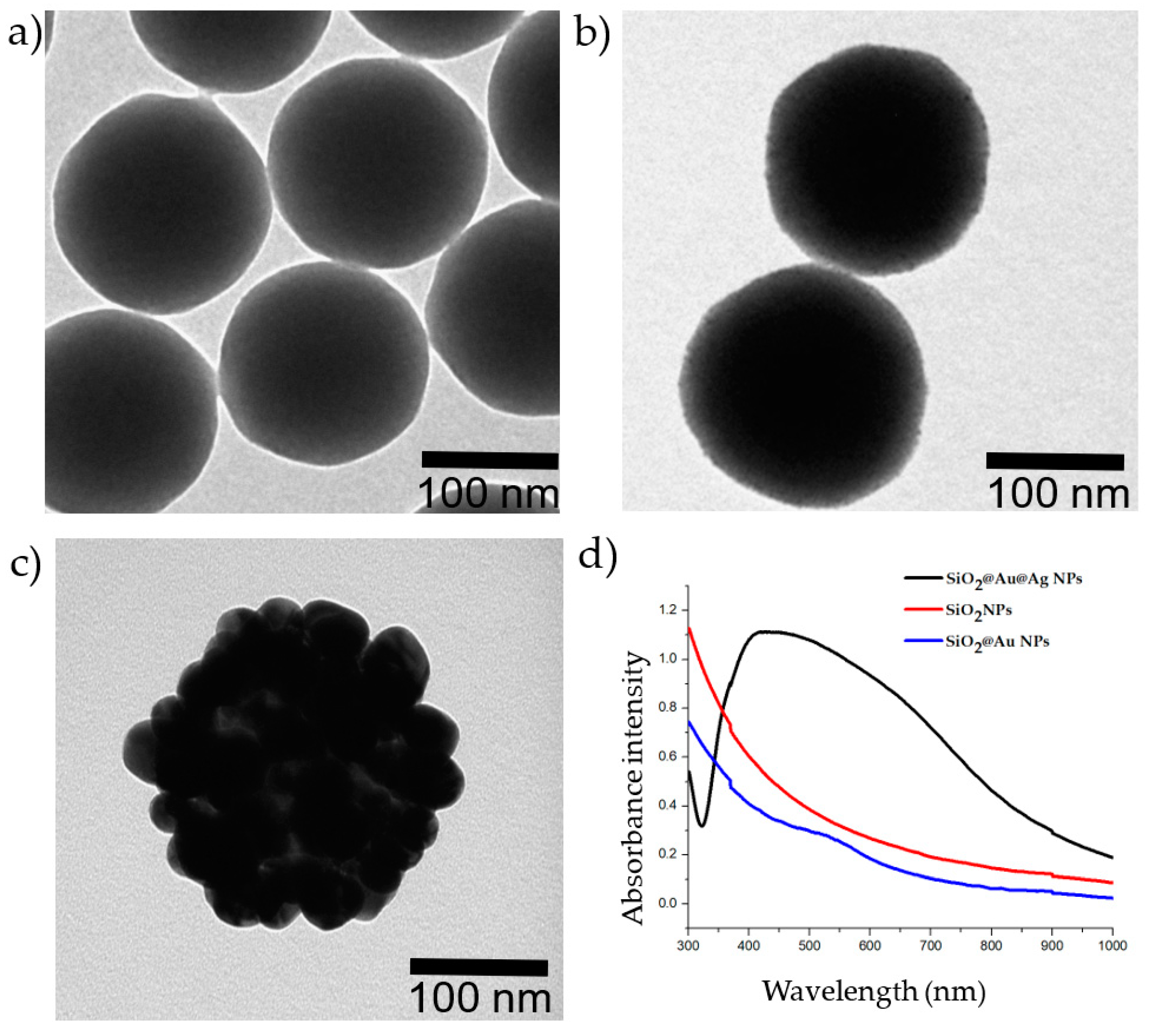
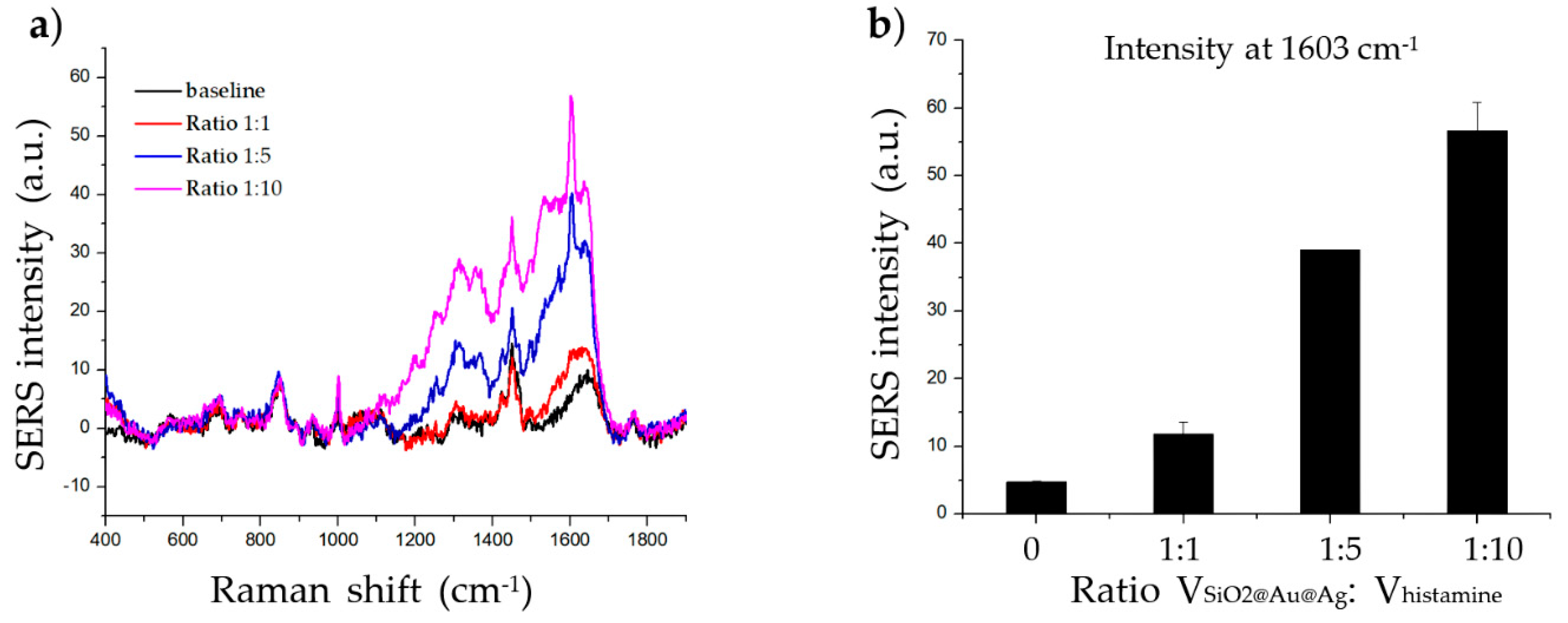
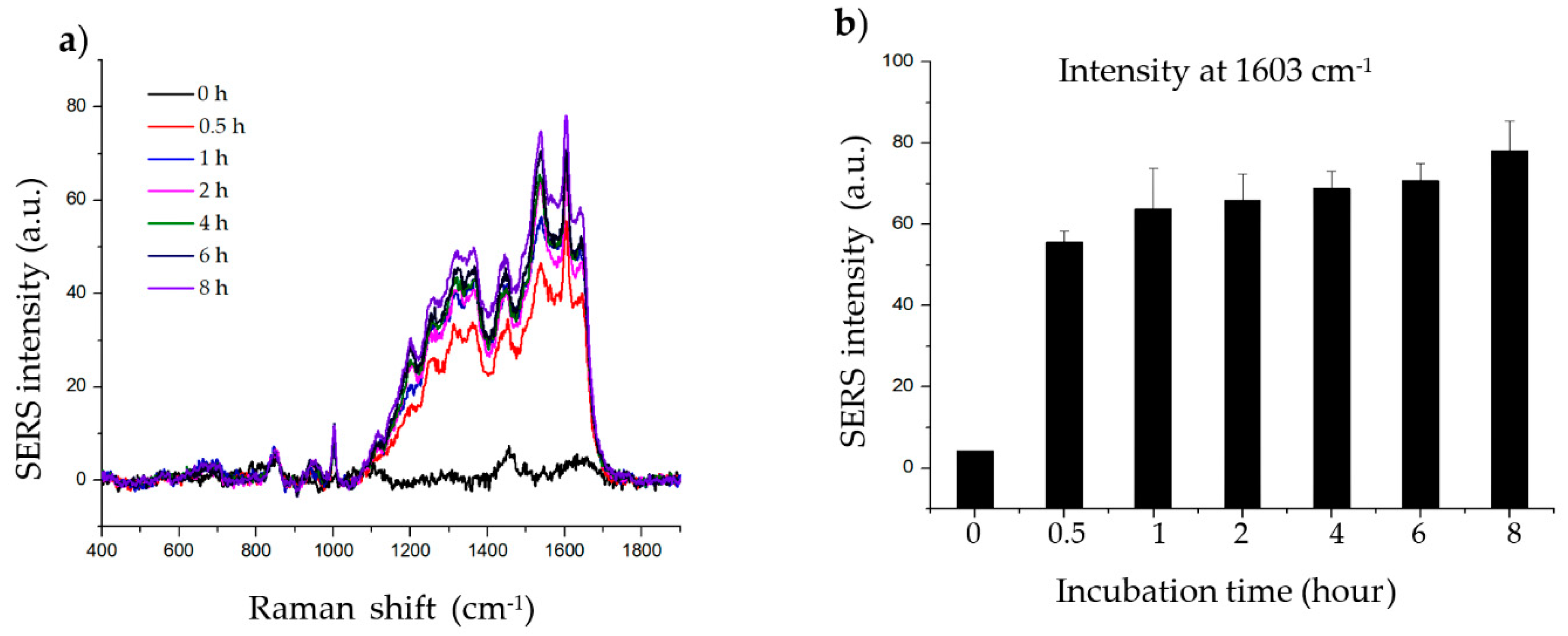
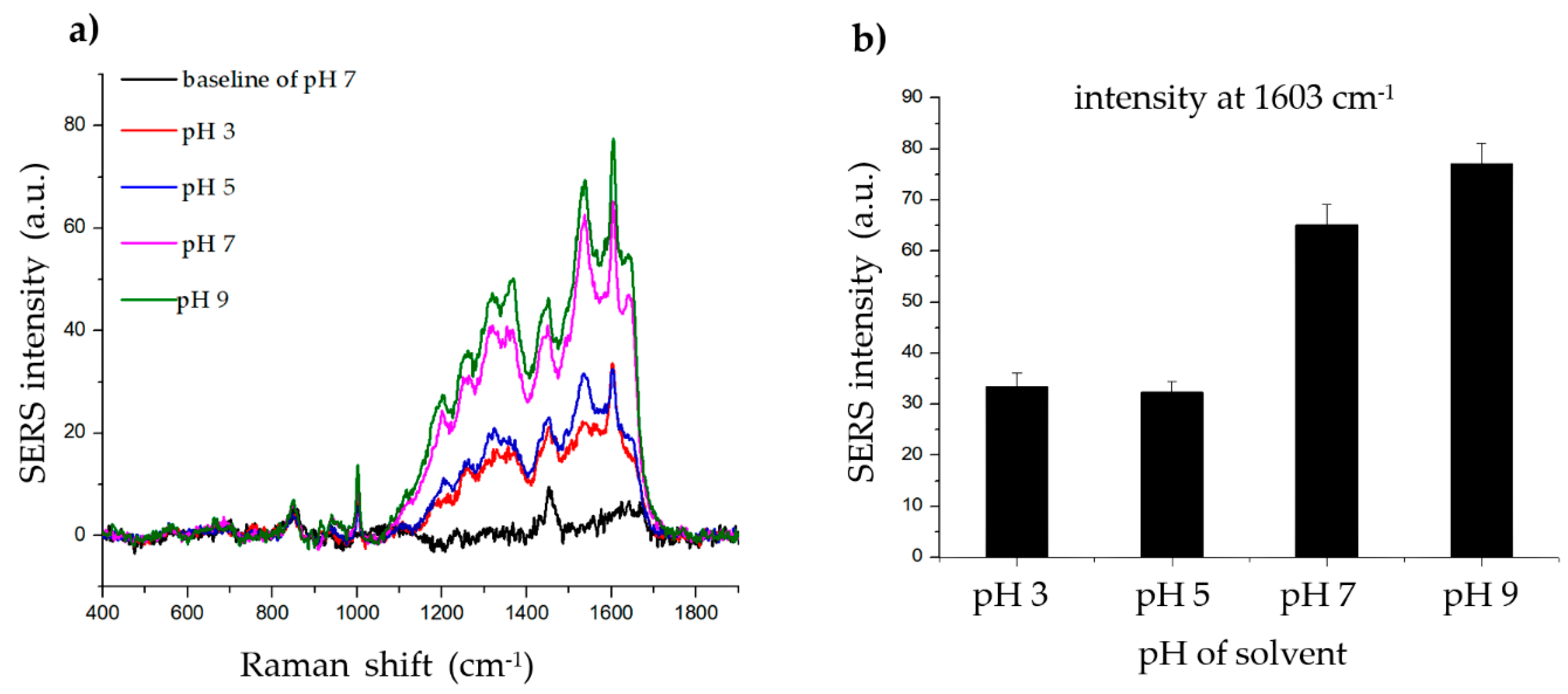
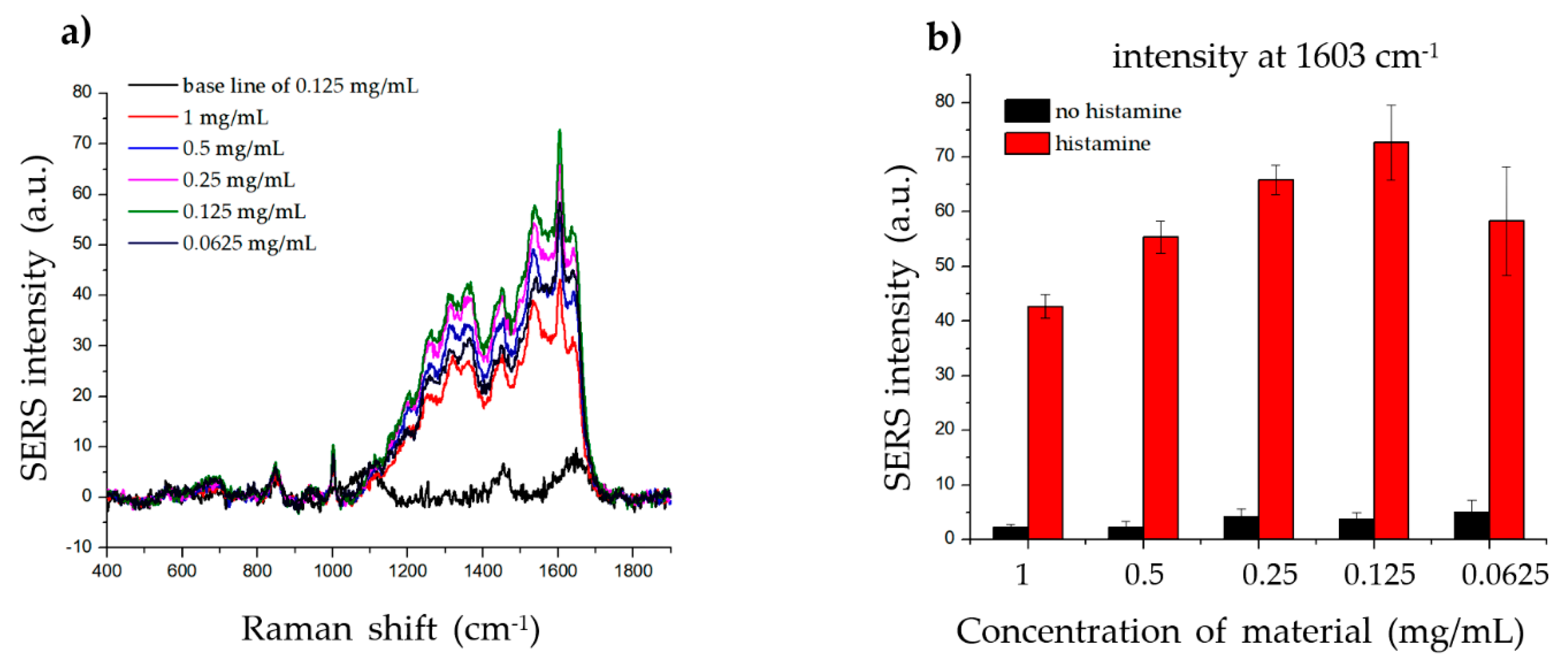
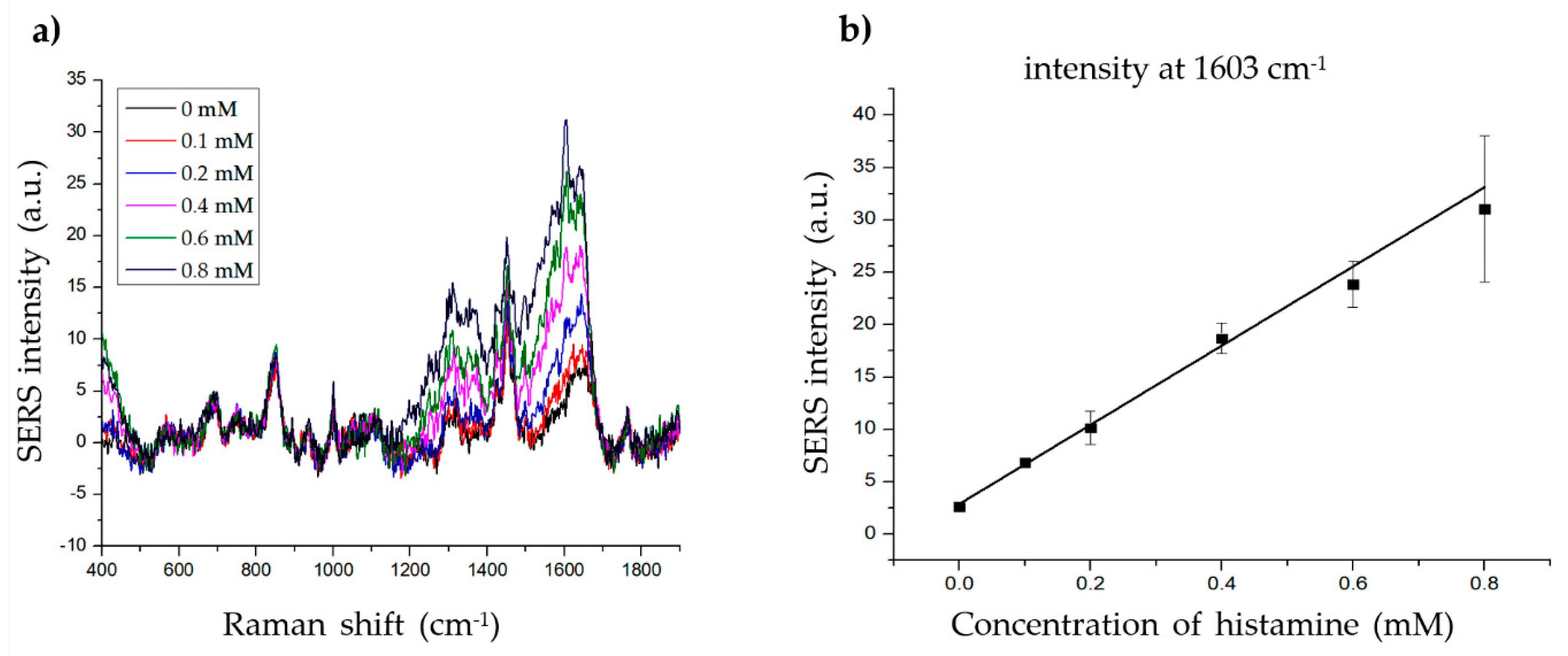
© 2020 by the authors. Licensee MDPI, Basel, Switzerland. This article is an open access article distributed under the terms and conditions of the Creative Commons Attribution (CC BY) license (http://creativecommons.org/licenses/by/4.0/).
Share and Cite
Huynh, K.-H.; Pham, X.-H.; Hahm, E.; An, J.; Kim, H.-M.; Jo, A.; Seong, B.; Kim, Y.-H.; Son, B.S.; Kim, J.; et al. Facile Histamine Detection by Surface-Enhanced Raman Scattering Using SiO2@Au@Ag Alloy Nanoparticles. Int. J. Mol. Sci. 2020, 21, 4048. https://doi.org/10.3390/ijms21114048
Huynh K-H, Pham X-H, Hahm E, An J, Kim H-M, Jo A, Seong B, Kim Y-H, Son BS, Kim J, et al. Facile Histamine Detection by Surface-Enhanced Raman Scattering Using SiO2@Au@Ag Alloy Nanoparticles. International Journal of Molecular Sciences. 2020; 21(11):4048. https://doi.org/10.3390/ijms21114048
Chicago/Turabian StyleHuynh, Kim-Hung, Xuan-Hung Pham, Eunil Hahm, Jaehyun An, Hyung-Mo Kim, Ahla Jo, Bomi Seong, Yoon-Hee Kim, Byung Sung Son, Jaehi Kim, and et al. 2020. "Facile Histamine Detection by Surface-Enhanced Raman Scattering Using SiO2@Au@Ag Alloy Nanoparticles" International Journal of Molecular Sciences 21, no. 11: 4048. https://doi.org/10.3390/ijms21114048
APA StyleHuynh, K.-H., Pham, X.-H., Hahm, E., An, J., Kim, H.-M., Jo, A., Seong, B., Kim, Y.-H., Son, B. S., Kim, J., Rho, W.-Y., & Jun, B.-H. (2020). Facile Histamine Detection by Surface-Enhanced Raman Scattering Using SiO2@Au@Ag Alloy Nanoparticles. International Journal of Molecular Sciences, 21(11), 4048. https://doi.org/10.3390/ijms21114048





